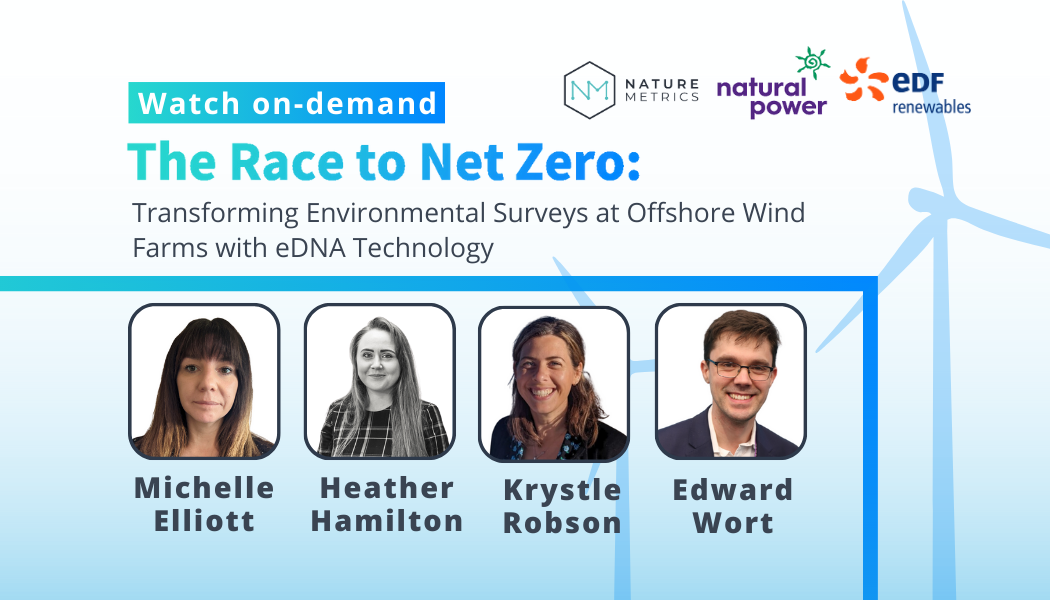With Governments and the energy industry rapidly transitioning to renewable energy sources, Offshore Wind will play a vital role in our journey to net zero. At the same time, more stringent nature reporting requirements mean that developers must monitor and mitigate their impact on biodiversity.
These dual pressures have stretched Offshore Wind developers' supply chains and environmental monitoring capabilities, particularly as traditional methods for measuring marine biodiversity are time-consuming and expensive.
In response to these challenges, leading experts at EDF Renewables, Natural Power and NatureMetrics developed a project to demonstrate how environmental DNA (eDNA) sampling and analysis presents a commercially viable alternative to traditional fish ecology surveys.
The project, undertaken at Blyth Offshore Demonstrator (BOD) off the coast of Scotland, compared eDNA testing – which captures tiny traces of DNA left behind by different species – with traditional trawl-based methods. It also sought to understand if eDNA could reduce survey costs and sampling efforts.
A careful balancing act
During the webinar, Heather Hamilton, UK Consents and Environment Manager at EDF Renewables, explained that the UK government has committed to increasing renewable sources of energy – including 50 gigawatts of offshore wind – by 2030. At the same time, offshore wind developments will also be required to demonstrate a net gain in marine biodiversity.
Meeting these targets creates challenges at an operational level. As Heather explained: "The strive for net zero is placing increasing pressure on the existing supply chain, which is often associated with wind farm components, but is increasingly also an issue affecting environmental surveys as demand for survey vessels and ecologists increases."
New legislative and regulatory frameworks, such as The Taskforce on Nature-Related Financial Disclosures (TNFD), are introducing additional biodiversity monitoring requirements that require robust and repeatable survey data that traditional surveying techniques struggle to fulfil.
Michelle Elliot, Principal Consultant at Natural Power, added: "To ensure the just transition to renewable energy, environmental services have become a key part of the consenting process. However, it is not uncommon for delays to environmental services to cause a knock-on delay to the development."
Michelle said traditional methods like trawling could miss migratory and other ecologically important species. They also presented other practical challenges. "Weather delay can make it difficult to find suitable weather windows to trawl safely, meaning that surveying at regular intervals throughout the year can be difficult," said Michelle.
"It is also difficult or infeasible to trawl close to the turbines themselves as the potential for snagging gear poses a health and safety risk."
Key findings from the study
During the study, four surveys were conducted over 12 months to capture seasonal variation, such as migratory fish. During that time, eDNA testing consistently detected more species than trawl data.
eDNA detected 54 fish species, compared to 26 species in trawls. These included smaller species and bottom-dwellers often not captured by fishing gear.
In addition to fish, eDNA also provided data on other important species groups. Michelle said: "Four marine mammal species were captured using eDNA data, and we could see the seasonal occurrence of those species - which is important in offshore winds in terms of thinking of mitigation and timing of construction activities."
The study also found that, in addition to identifying individual species trends, eDNA could be used to calculate ecological diversity metrics and track seasonal and spatial differences in community composition.
Life within the turbines
eDNA sampling also made it possible to survey areas adjacent to turbines for the first time.
As Edward Wort, Marine Specialist & Survey Design Lead at NatureMetrics, explained: "One of the advantages of eDNA is that all that's required is a Niskin bottle to pick up your water
sample if you're dealing with an offshore environment. So you can get right in amongst the wind turbines, which you can't if you're trawling a net."
Michelle said: "The eDNA method also allows us to assess the species composition within the turbines themselves, which we have never been able to do at Blyth. So that was very exciting for us."
Fish species, particularly bottom-dwelling species, were generally found at higher relative densities within the turbines than outside them.
"These findings support the hypothesis that the artificial substitute created by the turbines may be providing shelter and feeding grounds for fish," said Michelle.
Using eDNA to understand our marine environments
The study demonstrates that eDNA-based surveys are a market-ready solution to optimize consenting phase surveys of offshore wind site development, as well as ongoing monitoring and targeted mitigation strategies.
Heather said: "The adoption of the method has the potential for huge benefits to the wider industry by providing a safer, more efficient, affordable and scalable solution which would speed up development and ultimately reduce the cost of overall energy production while obtaining the environmental data required for all of our environmental assessments."
Heather added that there is a growing need to monitor the progress of the net gain projects. "The use of eDNA methodologies could enable this monitoring to be done non-intrusively by monitoring the changes in biodiversity over time, providing that ecosystem-wide view."
In addition to offshore wind, the study shows the potential of using eDNA in other marine environments, such as solar, wind and tidal.
NatureMetrics' Industrial Offshore Lead Krystle Robson concluded: "There's a lot of potential applications in the marine space for eDNA. This project has really helped to demonstrate the power of eDNA.''





%20(2).png)
.jpg)


.jpg)